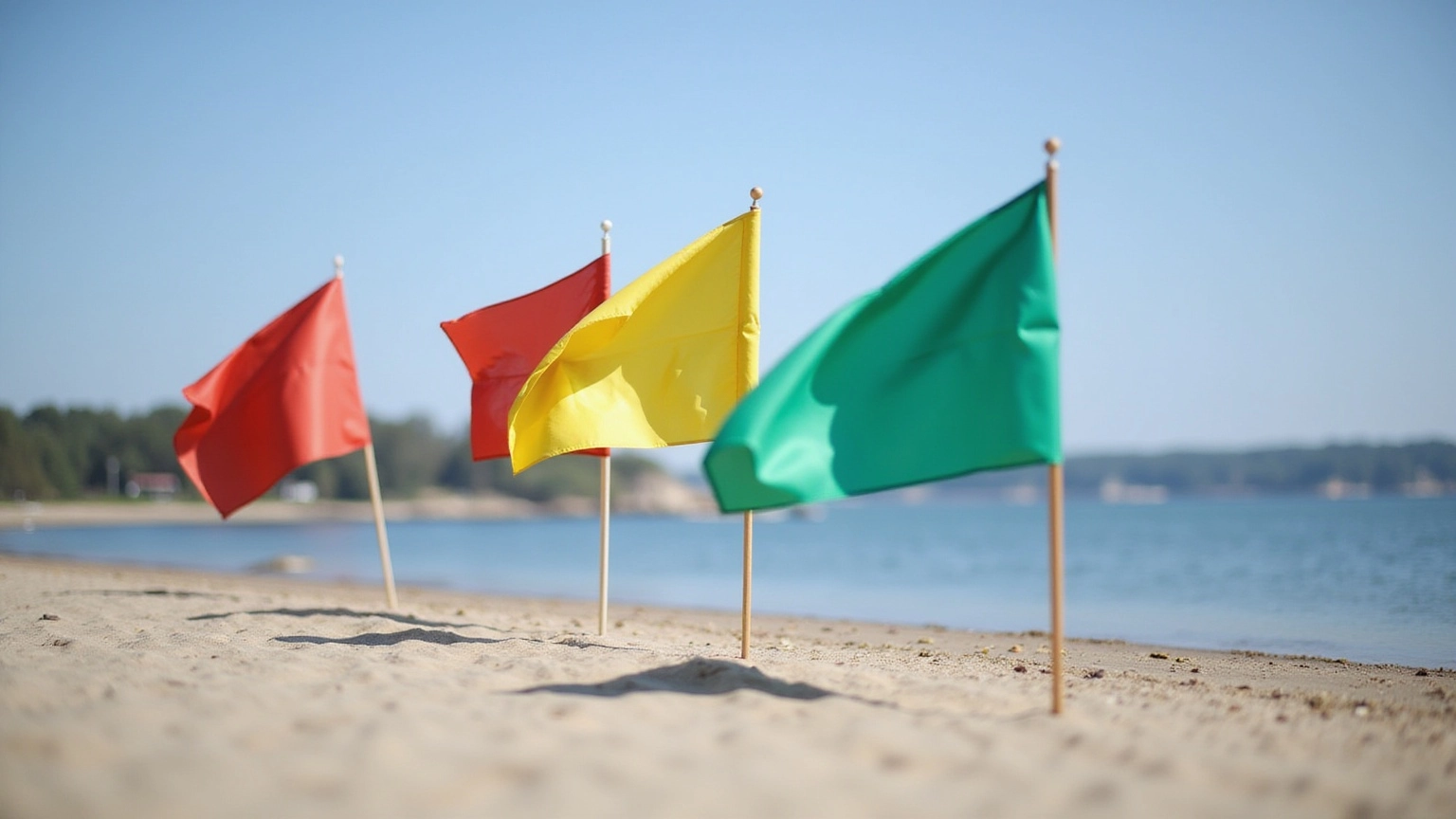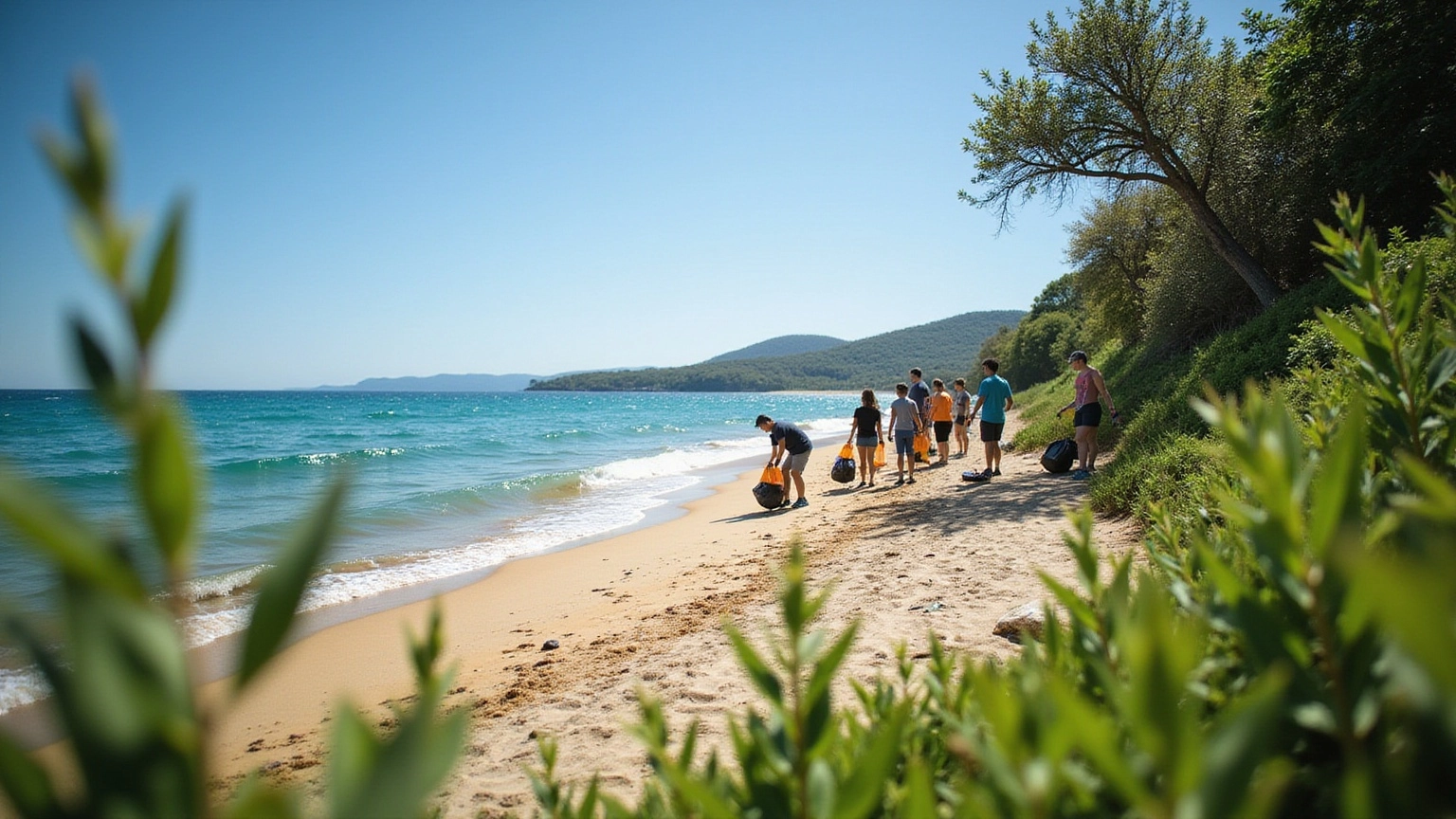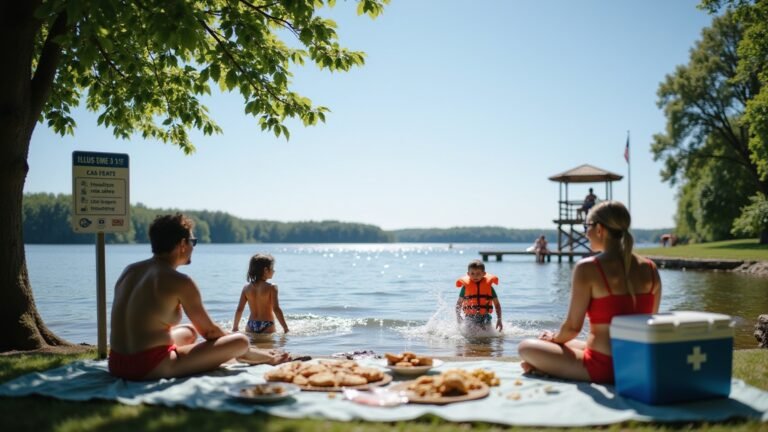Overview
This article shares some fantastic best practices for enjoying beaches and lakes, and it highlights the importance of safety measures. You’ll want to be aware of potential hazards, consider formal swim instruction, and always adhere to local guidelines. These recommendations are backed up with some eye-opening statistics on drowning risks, the crucial role of life jackets, and the necessity of checking water quality reports. All of this is aimed at making your aquatic adventures not only safe but also incredibly enjoyable!
Key Highlights:
- Safety at beaches and lakes is critical; awareness of hazards like strong currents and wildlife is essential.
- Formal swim instruction can reduce drowning risks by up to 88%, emphasizing the need for aquatic education.
- If a child goes missing, check water sources first; 69% of young drowning victims were not expected to be near water.
- Effective protection measures include teaching life-saving skills, wearing life jackets, and ensuring proper supervision.
- Local guidelines and advisories should be familiarized to enhance safety while enjoying aquatic activities.
- Health risks from bacteria in natural water bodies can increase after rainfall; checking local quality reports is vital.
- Understanding warning flags and safety advisories is crucial for reducing accidents at beaches and lakes.
- Personal safety measures, such as knowing swimming limits and wearing life jackets, are essential for enjoyment and security.
- Awareness of beach rules and regulations helps prevent accidents and protect local wildlife.
- Emergency preparedness, including knowledge of first aid and communication plans, can save lives in incidents.
- Responsible waste disposal and community conservation efforts are vital for protecting natural resources at beaches and lakes.
Introduction
As summer approaches, the allure of beaches and lakes calls to us, promising relaxation and adventure! But amidst all that sun-soaked fun, it’s important to stay aware and prepared to ensure our safety in these beautiful natural playgrounds. From understanding local hazards and checking water quality to mastering essential safety measures, being informed can truly make the difference between a delightful outing and a dangerous situation.
In this article, we’ll dive into crucial aspects of beach and lake safety, offering insights on how to enjoy these stunning environments while prioritizing your well-being and being kind to the environment. Whether you’re planning a family trip or a solo excursion, remember: knowledge is the key to a safe and enjoyable experience by the water!
Understanding Beach and Lake Safety
Ensuring safety at beaches and lakes is crucial for an enjoyable experience! Being aware of potential hazards—like strong currents, wildlife encounters, and changing environmental conditions—is essential for all visitors. Did you know that formal swim instruction can decrease the risk of drowning by as much as 88%? This really highlights the importance of teaching children vital aquatic skills!
Additionally, if a child goes missing, it’s advisable to check water sources first. Up to 69% of young children found drowned or submerged in swimming pools were not expected to be near the water. That’s a staggering statistic that underscores the need for vigilance.
To enhance security while you enjoy the natural wonders of beaches and lakes, familiarize yourself with local guidelines and advisories. Typical dangers at these spots include:
- Rip currents
- Sudden weather changes
- The presence of wildlife
Implementing effective protection measures—like teaching life-saving skills, wearing life jackets, ensuring proper supervision, and installing barriers such as pool fences—can significantly reduce risks.
Effective beach protection initiatives show that joint efforts between local authorities and non-profit groups can lead to a significant reduction in drowning occurrences. How amazing is that?
Experts emphasize the importance of vigilance and education in water safety. Capt. Amy Beach, a director of Inspections and Compliance, shares, “We commend our state and non-profit partners in boating security who have worked to decrease casualties through educational outreach and enforcement.”
By staying informed and proactive, you can fully appreciate the beauty of beaches and lakes while keeping safety as your top priority!
Essential Preparations Before Your Visit
Before you set off on your adventure to the beaches and lakes, it’s super important to pack the right gear and supplies to ensure your experience is both safe and enjoyable. Think about essentials like:
- Sunscreen to shield your skin from those pesky UV rays
- Plenty of fluids to keep you hydrated
- Nutritious snacks to fuel your fun
- A well-stocked first aid kit for any little mishaps
Plus, don’t forget to check the weather forecast and local advisories regarding safety and water quality!
For example, did you know that certain areas, like California, have a high number of unguarded drowning incidents? This really underscores the importance of being informed and prepared. And speaking of safety, kayaking on Lake Superior has unfortunately claimed the lives of six kayakers from 2018 to 2021, which emphasizes the need for safety measures when you’re out on the water.
Real-life stories show just how crucial preparation can be: travelers who take the time to plan their seaside getaways often report having a much more enjoyable time, free from the stress of unexpected challenges. As we look ahead to 2025, packing tips suggest bringing:
- Lightweight, quick-dry towels
- Portable beach chairs
- Eco-friendly containers for your snacks and drinks
And let me tell you, having a waterproof phone case can be a game changer for capturing those unforgettable moments while keeping your device safe!
As Jessica, a fellow travel enthusiast, puts it, “I believe that sometimes you save and sometimes you splurge, and I’ll help you figure out how to have the best travel experiences ever.” By being prepared, you not only enhance your enjoyment at the beaches and lakes but also minimize the risks associated with unexpected conditions. This way, your time spent exploring will be both memorable and safe!
Identifying Risks: Bacteria and Water Quality
Natural bodies, like beaches and lakes, can sometimes pose health risks due to harmful bacteria, especially after heavy rainfall or in stagnant conditions. Recent studies have shown that fecal indicator bacteria (FIB) levels can be influenced by various factors, including the presence of homeless populations, which often correlate with higher FIB exceedances. A case study titled ‘Influence of Homeless Populations on FIB Levels’ highlights this relationship, underscoring the importance of understanding local quality dynamics.
Before you dive into aquatic activities, it’s essential to check local advisories for the latest quality reports. These reports often provide insights into the conditions for enjoying water activities, especially in 2025, when monitoring practices have improved significantly. For instance, studies suggest that quick quality testing techniques can predict health impacts related to aquatic activities, allowing you to make informed decisions about your recreational safety.
As R. Haugland noted, “The use of faster indicators of recreational water quality will result in the ability to make decisions about recreational water quality on the day of sample collection.”
It’s wise to avoid water activities at beaches and lakes that show visible pollution or shortly after rainfall, as these conditions can heighten the risk of waterborne illnesses. Statistics reveal that certain coastal types, like beaches and lakes, are more prone to FIB exceedances, emphasizing the need for caution when choosing your recreational spots. For example, the type of beach or lake plays a significant role in FIB exceedances, highlighting the importance of being aware of the specific hazards associated with these aquatic environments.
By staying informed about aquatic quality, you can significantly reduce health risks and enjoy your time in nature safely. Health officials emphasize that being proactive about assessing quality before swimming is crucial. This proactive approach not only enhances your personal safety but also contributes to broader public health efforts aimed at keeping our recreational waters clean and secure.
How to Assess Water Conditions and Advisories
Before you dive into the water, it’s essential to check the conditions. Keep an eye out for warning flags and signs that indicate quality and safety. Familiarize yourself with local resources that provide real-time updates on aquatic conditions, like shoreline monitoring websites and specialized apps available in 2025. These tools can give you vital information about current water quality, potential hazards, and advisories specific to each beach and lake.
Understanding how to interpret these advisories is crucial for your well-being. For instance, while many beachgoers recognize the red flag as a clear warning of danger, research shows that other flags often go unnoticed, leading to misconceptions about safety. This underscores the need for better design and public education regarding warning systems at beaches and lakes.
The design of these flags is key to how effectively they communicate safety information to the public.
Real-life examples highlight the importance of water safety advisories. In the Netherlands, a study revealed that public awareness of coastal warning flags is inconsistent, with only the red flag clearly signaling danger. This lack of clarity can lead to risky behaviors among beach visitors.
So, it’s not just about spotting flags at beaches and lakes; it’s also about understanding their meanings and the context in which they are displayed. As Beth, a Gulf Coast resident, shared, “I grew up on the Gulf. I know about rip currents. We taught our children about them, and still, we nearly had a tragedy.” Her experience emphasizes the real-life implications of coastal awareness.
By using available resources and being informed about the significance of warning flags, you can significantly reduce the risk of accidents and enjoy a safer coastal experience. Plus, local governments provide warning flags and interpretive signs at no cost to enhance public safety, so be sure to take advantage of these resources!

Personal Safety Measures: Know Your Limits
Swimming is such a delightful way to enjoy both beaches and lakes! However, it’s crucial to always operate within your abilities and comfort level. If you’re not a confident swimmer, I highly recommend wearing a life jacket, especially in open water where conditions can change rapidly. Did you know that a substantial segment of the population, particularly among Black adults, encounters obstacles to aquatic activities? In fact, 67% report no time spent at a pool in the last six months. This really highlights the significance of aquatic education and protection initiatives aimed at marginalized communities.
As William Ramos, Ph.D., an expert in public health, notes, “The pandemic produced an event that impacted everyone at once – halting most programs in a way we have never had to navigate.” This really emphasizes the need for effective drowning prevention strategies, especially for groups disproportionately affected by drowning, like children and older adults.
To improve your safety, avoid being in the water alone, and make sure someone knows your location. Understanding your boundaries is crucial; it not only helps you avoid hazardous situations but also enhances your enjoyment of aquatic activities. As aquatic instructors often emphasize, knowing your limits can make all the difference between a fun day at the beach or lake and a potentially dangerous experience.
In 2025, the importance of life jackets cannot be overstated, especially in open aquatic environments. Current data shows that many swimmers don’t consistently use life jackets, which can significantly increase the risk of drowning. By prioritizing personal safety measures and embracing education on aquatic skills, you can enjoy the environment with greater confidence and security.
The Design Tourist blog is a great example of how combining expert storytelling with practical travel advice can transform ordinary trips into extraordinary journeys. It really underscores the importance of safe water activities as part of a fulfilling travel experience!
Understanding Beach Rules and Regulations
When you’re out exploring beaches and lakes, it’s super important to know the specific regulations that govern aquatic activities, boating, and other fun pursuits. These rules often include designated aquatic zones, restrictions on alcohol consumption, and guidelines that help protect local wildlife. Following these guidelines is essential—not just for your safety but also for the conservation of the beautiful natural surroundings we all love.
In 2025, many beaches and lakes have updated their regulations to enhance security and environmental management. For example, the enforcement of swimming area guidelines has tightened up, with clear markings for designated zones to help prevent accidents and ensure safe swimming conditions. The Environmental Protection Agency (EPA) has provided guidance for states to use Action Values as thresholds for public notifications about water quality, which is crucial for understanding the regulatory framework related to coastal safety.
Did you know that sticking to these regulations can significantly reduce the risk of drowning and other water-related incidents? Real-life examples show just how effective these rules can be. In recent years, several beaches have reported a noticeable drop in violations thanks to increased public awareness campaigns and stricter enforcement measures. These initiatives have really made a difference in promoting compliance with local swimming and boating regulations, leading to safer recreational experiences for everyone.
And let’s not forget about the importance of wearing life jackets! Legislation now requires that children under 12 must wear life jackets on smaller boats, and every recreational vessel must have an approved life jacket for each passenger. This requirement comes from numerous case studies highlighting how life jackets play a vital role in preventing drowning incidents, especially in unpredictable aquatic conditions. It’s a great idea for parents to talk to their kids about the risks of open water and to lead by example by wearing life jackets themselves.
So, as you gear up for your next trip to the beaches and lakes, take a moment to review the current rules and regulations. By doing this, you’re not just looking out for yourself—you’re also contributing to a safer environment for everyone while soaking in the beauty and tranquility of these amazing natural settings.
Emergency Preparedness: What to Do in Case of an Incident
In emergencies like drowning or injury, prompt and informed responses can truly be life-saving! It’s so important to familiarize yourself with basic first aid procedures, such as CPR and how to manage choking incidents. Knowing where the nearest lifeguard station or emergency services are located is essential, as they can provide immediate assistance when it’s needed most.
Establishing a clear plan for contacting help is key. Make sure everyone in your group understands the steps to take in case of an incident—communication is everything!
Did you know that in 2022, 676 individuals aged 5 to 24 drowned? This statistic really emphasizes the significance of staying vigilant and prepared at recreational aquatic locations. Plus, it’s worth noting that 9 percent of pediatric drowning deaths occurred in portable pools, highlighting the specific risks associated with different swimming environments. Emergency response efforts often involve multiple agencies, including local police and the Coast Guard, so coordinated action is crucial.
To enhance safety, consider these expert tips:
- Always swim in designated areas supervised by lifeguards
- Avoid distractions while supervising children
- Ensure that everyone in your group knows the water safety rules
As one first aid trainer wisely said, “Being prepared and knowing how to respond can make all the difference in an emergency situation.” And don’t forget, having a first aid kit readily available can help address minor injuries promptly!
By being proactive and informed, you can significantly reduce the risks associated with beach and lake activities. This way, you’ll ensure a safer and more enjoyable experience for everyone!
Environmental Awareness: Protecting Our Natural Resources
Safeguarding our natural resources while enjoying beaches and lakes is so important for keeping these beautiful environments healthy! By following guidelines for waste disposal—like using designated trash and recycling bins—you can help minimize litter and its harmful effects on local ecosystems. Did you know that littering can significantly impact our natural resources? Studies show that improperly disposed waste often leads to increased pollution levels in water bodies, affecting both wildlife and human health.
Moreover, the average percentage of potentially unsafe days by county highlights ongoing safety issues at various coastal areas, underscoring the need for responsible behavior.
You can enhance your efforts by participating in local conservation initiatives! Community projects, such as shoreline clean-ups and habitat restoration, have proven effective in preserving these natural spaces. For example, the shoreline restoration project at Mispillion Inlet in Delaware not only repaired erosion damage but also improved habitats for local wildlife, including the federally listed piping plover.
This project is a great example of how community efforts can lead to positive outcomes in environmental conservation. It really highlights the importance of being aware of our surroundings while enjoying activities at our beloved beaches and lakes. Tony Dutzik, Associate Director and Senior Policy Analyst at Frontier Group, emphasizes that education on the impact of human activities on natural resources is crucial. He encourages all of us visiting beaches and lakes to be mindful, helping to preserve the delicate balance of these ecosystems.
Looking ahead to 2025, the focus on environmental protection at beaches and lakes remains vital. This summer, 22 State Park shorelines reported swim advisories due to pollution issues, while 15 did not. This really highlights the ongoing need for vigilance and proactive measures to protect these cherished spaces. By taking simple actions like picking up litter and joining local conservation efforts, you can make a difference in preserving our beautiful beaches and lakes!

Conclusion
Staying safe at beaches and lakes is all about understanding potential hazards and taking proactive measures. You’ll want to be aware of local conditions, like water quality and environmental factors, to ensure a fun and safe outing. By getting familiar with safety guidelines, packing the right supplies, and being ready for emergencies, you can really boost your enjoyment while keeping risks at bay during your water adventures.
Education is key when it comes to beach and lake safety. Knowing what those warning flags mean and understanding your personal limits empowers you to make safe choices. Plus, following local regulations and being aware of environmental impacts can make your experience even better. And hey, getting involved in community conservation efforts is a fantastic way to help protect these beautiful natural resources, making sure they stay accessible and stunning for everyone to enjoy.
Ultimately, when you prioritize safety and environmental stewardship, you can fully soak in all the relaxation and adventure that beaches and lakes have to offer. By taking informed steps and embracing responsible behaviors, you’re setting the stage for memorable and safe experiences in these gorgeous natural playgrounds. So, let’s dive in and make the most of our time by the water!
Frequently Asked Questions
Why is safety at beaches and lakes important?
Ensuring safety at beaches and lakes is crucial for an enjoyable experience, as it helps visitors be aware of potential hazards like strong currents, wildlife encounters, and changing environmental conditions.
How can formal swim instruction impact drowning risks?
Formal swim instruction can decrease the risk of drowning by as much as 88%, highlighting the importance of teaching children vital aquatic skills.
What should I do if a child goes missing near water?
If a child goes missing, it’s advisable to check water sources first, as 69% of young children found drowned or submerged in swimming pools were not expected to be near the water.
What are some typical dangers at beaches and lakes?
Typical dangers include rip currents, sudden weather changes, and the presence of wildlife.
What protection measures can reduce risks at beaches and lakes?
Effective protection measures include teaching life-saving skills, wearing life jackets, ensuring proper supervision, and installing barriers such as pool fences.
How can joint efforts improve water safety?
Effective beach protection initiatives show that collaboration between local authorities and non-profit groups can lead to a significant reduction in drowning occurrences.
What essentials should I pack for a beach or lake adventure?
Essentials to pack include sunscreen, plenty of fluids, nutritious snacks, and a well-stocked first aid kit.
Why is it important to check the weather forecast before going to the beach or lake?
Checking the weather forecast and local advisories regarding safety and water quality is important to ensure a safe and enjoyable experience.
What are some recommended packing tips for a beach trip?
Recommended packing tips include bringing lightweight, quick-dry towels, portable beach chairs, eco-friendly containers for snacks and drinks, and a waterproof phone case.
How does preparation affect the overall experience at beaches and lakes?
Travelers who take the time to plan their seaside getaways often report having a more enjoyable time, free from the stress of unexpected challenges, thus enhancing their overall experience.


































